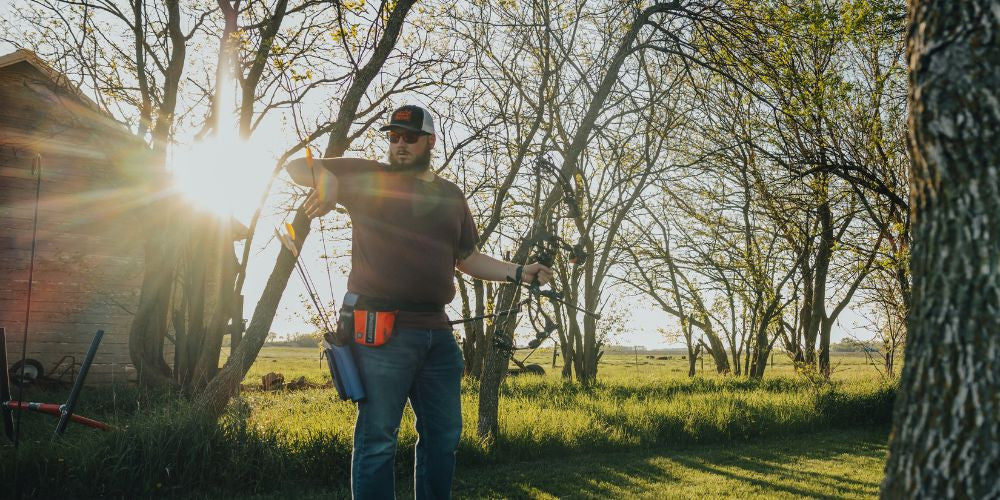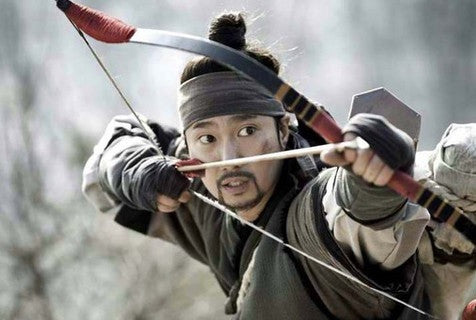The story of Traditional Asian archery continues with the champions of the current modern target archery: Korea. Although the Koreans are masters of target archery they have a long standing tradition with the bow and arrow stretching back for thousands of years. The bow was primarily a weapon used to unify the Korean peninsula over 1300 years ago and then later to repel the Japanese invaders in the late 16th century when Toyotomi Hideyoshi tried to conquer Korea and China. The Koreans used two types of bow, one is a modern laminated bow, the other is a traditional Korean composite bow similar to the Mongol bow called a Gakgung. Gakgung means ‘nation bow’ and it’s made from several different materials. It comprises of a bamboo core, which is sinew backed with an oak handle. The belly of the bow has a water buffalo horn and the outer ends of the limbs are made of mulberry or acacia which is spliced onto the bamboo. The average draw weight of these bows is about 50 pounds and have a range of up to 400 meters. They were quite short when strung with a length of about 125 cm. This made them useful for horseback as well marching across the battlefield. In Korea there is a name for Korean traditional archery called ‘gungsul’, ‘kuk kung’ or ‘goongdo’, which translates brilliantly into ‘the Art of the bow’.

To fire the bow the Koreans used their own thumb ring but it was different from that used by the Mongols, Manchus and Turks. Korean thumb rings are called the gakji and it’s available in two types, one for men and one for woman. The male thumb ring sticks out as an extra appendage, while the female thumb ring covers the front joint of the thumb only. Both of them used to be made of the horn of water buffalo but now it’s possible to buy them made out of plastic.


The history of Traditional Korean Archery is so vast and steeped in culture that it’s story reads like a novel about glory, power, passion and intrigue. With all the tales to tell here I think it deserves to make this post it’s own title. The tales here began with the Korean wars with the Chinese dynasties and nomadic peoples recorded from the 1st century BC. This was the time of the ancient Three Kingdoms of Korea that dominated the Korean peninsula: Goguryeo, Baekje and Silla. Legend has it that the founder of Goguryeo, Go Jumong was a master of archery with such an impressive ability that he was able to catch 5 flies with one arrow. The first king of Silla, Park Hyeokgeose was a highly skilled archer. The ancient Chinese heard of these archers and were aware of their potential as military opponents in combat. The Chinese had already been masters of archery over a thousand years earlier, as it was one of the Six Noble Arts of the Zhou dynasty from the 12th – 3rd century BC. When Genghis Khan began his campaign across Asia and Europe the Mongols began invading Korea from 1231 – 1259. The Mongols with their brilliant and powerful bow technology were no match for the Korean army who were armed largely with swords and spears. When the Mongols went onto rule the proto-Korean state of Goryeo in 1270 a military regime was enforced and the Koreans learnt how to master the composite bow in a rebellion against their Mongol Yuan rulers. The Goryeo dynasty became a governor of a vassal state and a compulsory ally of the Yuan dynasty for 80 years. When the reign of the Yuan dynasty collapsed in China in the 1350s, King Gongmin pushed the Mongolian garrisons back and they reclaimed the Korean peninsula. From then on Korea would become the master nation of archery.

In 1392 the state of Goryeo was no more when the modern came into being with the arrival of the Joseon dynasty. The Joseon’s first head of state was it’s founder Yi Seonggye who was known to have been a master archer. He was one of the Korean warlords that brought about the end of the Mongol rule during the late 1370s and early 1380s. During that time repelled organized Japanese pirates in a series of battles along the Korean coastline. Armed with a Korean gakgung bow there is an adventure in which he killed a samurai commander called Agibaldo with two arrows in a dramatic order. The first arrow knocked the warrior’s helmet off his head and the second arrow entered Agibaldo’s mouth.
Yi Seonggye was such a clever and powerful military leader he rose to the rank of general. During his time in the army he led a fight against the Red Turban Rebellion. The Red Turbans were a Chinese group of rebels who were opposed to the Yuan dynasty who contributed to it’s overthrowing. In 1359 they invaded Goryeo and took the city of Pyongyang when it was a staunch ally of the Yuan dynasty. Generals Yi and Choe Yeong of the Goryeo army pushed them back and out of the country. Yi supported the Ming dynasty and Choe was in favour of the Yuan dynasty and when the time came the two generals would become rivals in the royal court when the Ming dynasty came to power. After leading the Mongols out of Korea Yi withdrew from a planned assault on the Liaodong Peninsula and quickly returned to the Goryeo capital Gaesong and dethroned the Yuan supporting King U and took control of Korea. Afterwards he formally ended all Korean territorial ties to China.

Later Yi put forth the bow and arrow as the main stay of the Joseon military. Archery was so important to the Koreans that it became part of the national service exam held annually from 1392 to 1894. It was so important that Yi introduced a standard for the Royal Guard where they had to pass a set of tests which included hitting three bullseyes on a target 150 meters away. They also had to master riding on horseback while shooting in order to be able to defend the kingdom. Archery became such a powerful tool to Koreans that it led to the invention of several different types of arrow, one of the most famous of these was the pyeonjeon.

The pyeonjeon is one of the most powerful arrows that has secured the bow as a weapon that has saved a country. A pyeonjeon is a small ‘baby arrow’ that was fired from a gakgung from within a long bamboo shaft called a tong-a. This allowed a full size bow to shoot a short bolt and it was the Korean’s army secret weapon. It’s small size made it impossible for it to be reused by their enemies to and it allowed the Koreans to double or triple their ammunition in a siege. It also has advantage in doubling the range of the gakgung. With an ordinary arrow the gakgung could achieve a maximum range of over 400 meters, with a pyenjeon arrow up to 700 - 800 meters. This awesome potential of range and firepower made the Koreans almost impenetrable to foreign invaders. These so called baby arrows had longer range and flatter trajectory with a faster velocity and penetrating power. During the Joseon dynasty Korea was invaded 800 times and the gakgung and the pyenjeon repelled every attempt of an assault on Joseon. Korea was firmly established as the masters of archery. The pyenjeon came in useful in defeating the Japanese invasion of Korea during the Imjin wars in 1592 and the Manchu invasions of the early 1600s.

By the 1600s firearms started to replace bows and arrows across many Asian armies and so some armies such as the Japanese and the Koreans started to use rifles like the matchlock arquebus in the Imjin War. Despite this the Korean composite bow halted the Japanese at two major battles and firearms didn’t take over from the bow until much later until the reforms of King Gojong in 1894. Around this time Korean archery started to transition from a form of warfare to a recreational sport and the country underwent a series of sweeping reforms in government that saw Gojong as the first emperor of Korea. In 1899 Prince Heinrich of Prussia came to visit Korea and watched a number of shows of strength from the Korean martial arts. Among them was the archery which he said was familiar to that of Turkish and Hungarian archery. Heinrich convinced Emperor Gojong to reinvent the art of the bow from a millitary force to a recreational sport and so the nature of the bow and arrow was standardized. Korean traditional archery now uses one type of composite bow, bamboo arrows and a set target of about 145 meters. It was developed further under the Japanese occupation and it was formally written in a textbook called ‘Joseon eui Goongdo’ in 1920.

I have to say the history of Korean archery is a very fascinating tale. They took out their own conquers with their own inventive skills and took back their land. They have mystical heroes with a fine art in shooting arrows and crafting magnificent weapons of honor and glory. The bow and arrow gave them protection and strength for thousands of years and they survived all forms of invasions and abuse from major powers. I have a great admiration for the talents of Korean archers and I find their culture, history and skills with archery to be most exciting. They really are worthy of the title of masters of archery.
 cust@legendarchery.com
cust@legendarchery.com 302 503 5767
302 503 5767 Whitestown, In 47075
Whitestown, In 47075




